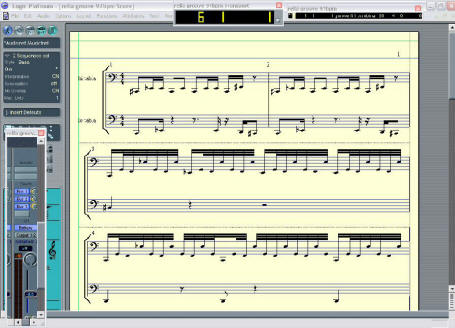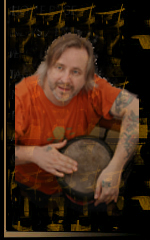| Programming Tabla
utilities |
Download the MIDI files (8kb)
Download the Battery sampler instruments (3kb)
Download the Hi Tabla kit samples (775kb) Download
the Lo Tabla kit samples (1008kb)
| A note on the Battery sets |
When I record Tabla in the studio I prefer a stereo pair, left for the
bass Tabla and right for the hi pitched
Tabla. This gives you some
concept of control over the bass and treble drums later in the mix. (For
a live situation a single mic is often preferred). With
this in mind, I will be making the overall sound of Tabla from two
software sample instruments, one for the bass tones and the other for
the treble tones. The instruments are already panned
+11 L and – 11R so
you do not need to get involved in any panning of them in the mix,
unless you want to create a different effect. The pan, set up as it is,
is for me the ideal balance of the two drums as they would sound to the
player. Have fun!!
Screen shots
1-9 Treble Tabla concepts
Screen shot 1;
Click to
enlarge
Having already normalized and trimmed our individual hits we import them
into battery. We want to put the samples in a configuration across the
keyboard which makes it easy to play patterns in by hand without crossing
over awkwardly.
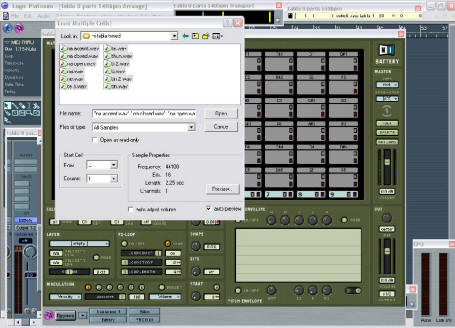
Screen shot 2;
Click to
enlarge
To do this we first import them towards the bottom of the page in
battery, in this instance from row C, column one. This is an option in
the original import window. Then you can drag and drop them onto the
chosen note number at the top of the screen. If you import them
one by one from the 'load samples' menu you can have trouble recalling
which ones have and have not already been imported. Also, some
software samplers do not audition from the load window so that could be
of concern.
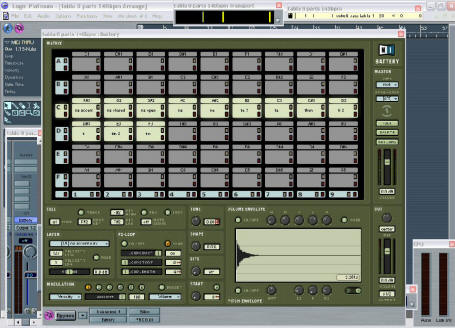
Screen shot 3;
Click to
enlarge
Then we turn on the drag and drop option in battery and select 'all but
midi'. This means that when you drag from say C2 to C1 then the note
will sound when you strike C1.
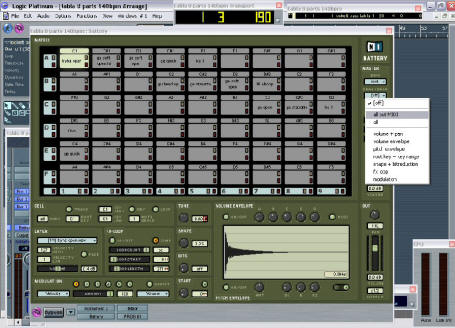
Screen shot 4;
Click to
enlarge
We have dragged the sample from row C, column 1 onto row A, column 1.
The original sample is duplicated on both notes at this point. Once you
are happy with the new position of the note at the top of the grid, select the original note
and choose 'delete' and then 'delete cell' from the pull down menu that
appears. This deletes the original sample from the program (Not from the
system or hard drive!) and leaves you with the new note on the key you choose. We
slowly go through this process note by note putting each individual
sample in a place on the keyboard, which suits your fingerings. Of
course, you could import each note individually but I find this more
time consuming and also more difficult to keep track of which ones I
have and have not imported.
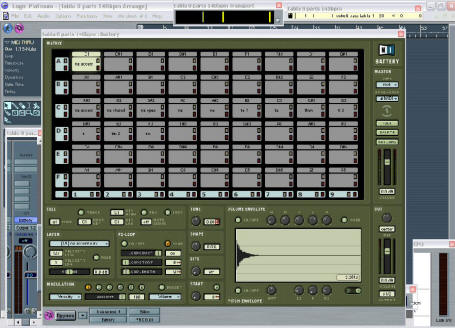
Screen shot 4b Hi Tabla set;
Click to
enlarge
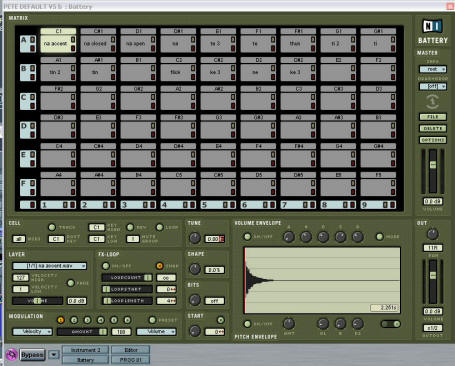
Screen shot 5;
Click to
enlarge
Here we have our first simple part involving two sounds on the treble
Tabla. The pattern is 'NA TIN TIN TIN'. We are using two slightly
different samples of 'TIN' to make the sound a little more inconsistent
and therefore more natural. We usually put a few of each sound in the sample
kits we build to achieve this end. Velocity is another method we could
use.
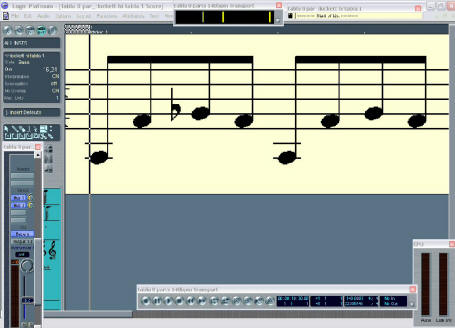
Screen shot 6;
Click to
enlarge
This second part is similar to pattern one with just a little more
space. We are going to look at a few treble drum patterns before moving
on to the bass parts. Notice how we have not put any open bass sounds in
this battery kit. We will be building a bass Tabla kit a little later.
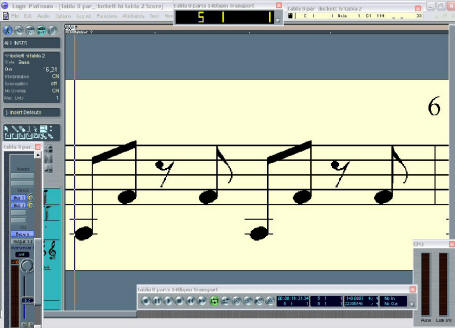
Screen shot 7;
Click to
enlarge
These type of treble Tabla parts are commonly found in a more folk style
of playing. It is this style that you more commonly hear applied to a
contemporary western environment. Looking at the matrix editor of this
example we can see how short the notes are. The sounds also are fairly
short but this is academic as they are one shot samples and sound until
another member of the mute group is sounded.
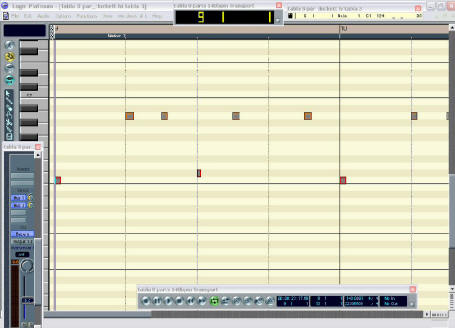
Screen shot 8;
Click to
enlarge
Here we introduce the closed 'na' sound. This is a very effective sound
when introduced into grooves. It is articulated by the finger remaining
on the skin after striking. It is sometimes called the 'chick'
stroke.
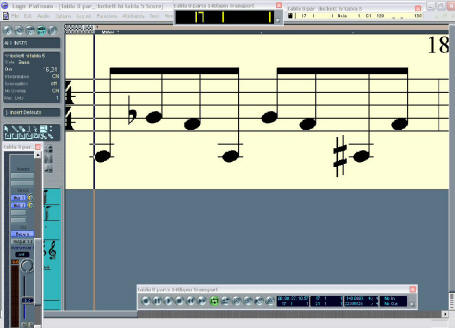
Screen shot 9;
Click to
enlarge
Now we have the characteristic open 'thun' sound. This sound really cuts
through and pops out of any mix. Like all the sounds in the hi Tabla
kit, it is on the same mute group. Think of the hi Tabla in the same way
you would a hi hat. Only one sound can sound at once. When a hi hat is
opened, it would sound a little odd to be simultaneously sound the
closed hi hat, presupposing you are trying to replicate something
natural sounding.
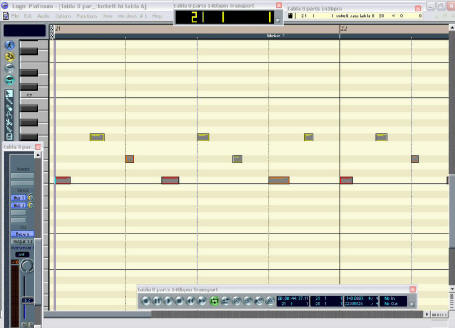
Screen shots
10-18 Bass Tabla concepts and fast groove patterns
Screen shot 10;
Click to
enlarge
Here we have our bass Tabla kit. Load this up on a separate audio
instrument channel. This is really four little mini bass Tabla kits in
one. From C1 thru D#1 we have four bass tabla tones. These are 1; open
2; hi medium 3; low medium 4; fast bend up. It is really these four
tones you need to create some simple versions of the nuances of the bass
Tabla. This then has the closed bass Tabla stroke 'KE' on the next note.
Then from C2 we have a similar set with slightly different nuances and
again upwards from C3 and C4. I like to put them across octaves like
this to make it easy to switch between different groups during
recording. If they are upwards in one group from C1 then it can be
difficult to orient yourself with the different sounds but simply moving
up an octave for the next set makes it easy to switch between sets in
performance.
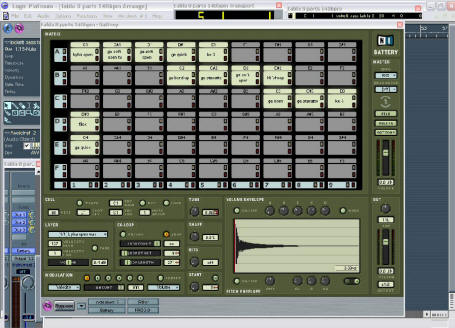
Screen shot 11;
Click to
enlarge
Guess what, a big surprise. It is a simple bass Tabla part. Because the
instrument is complex does no mean that you have to over program stuff
and make it too busy.
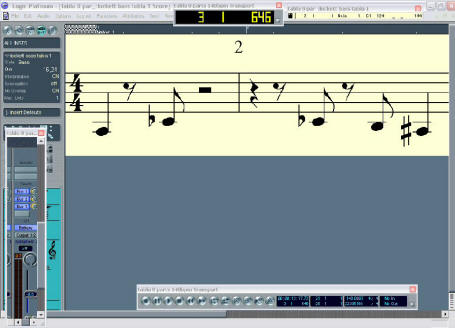
Screen shot 12;
Click to
enlarge
Here we see how this bass part sits with the corresponding treble Tabla
part. Notice the panning of the hi and low Tabla instruments. The bass
Tabla is 11L and the treble Tabla 11R. I don't like to split them any
further than this, ESP when some of the interlocked linear patterns
start to come out and you want it to sound as one instrument.
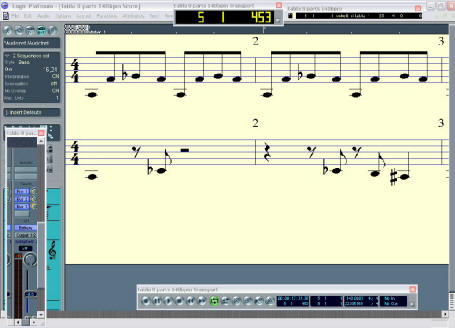
Screen shot 13;
Click to
enlarge
Here we have the bass and treble parts for the second midi groove.
Notice the melody and resolution of the shape of the bass Tabla part. As
an experiment, try putting all the bass Tabla hits on one sample and see
how it kills the part.
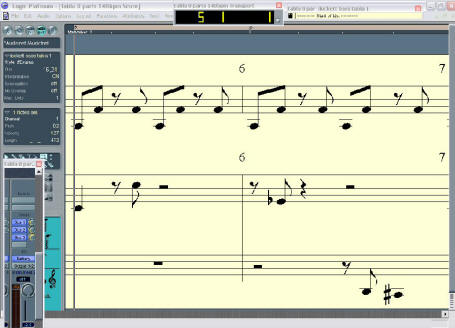
Screen shot 14;
Click to
enlarge
Another bass melody here. This one employs a little hi pitched flick at
the end. This is a version of the 'KE' stroke used for embellishment.
Notice how it pops out if a gap present in the hi Tabla part. If this
stroke was employed over another staccato stroke on the hi Tabla it
would not be nearly so effective.
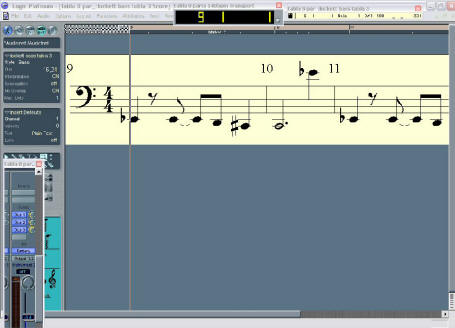
Screen shot 15;
Click to
enlarge
Tabla styles are famous for hi speed pick ups and techniques of doubling the
groove. This is the basis of our first hi speed groove for the treble Tabla. It only uses the 'NA' and 'TE' tones. We have used two versions
of the 'NA' stroke to give it more of a natural feel.
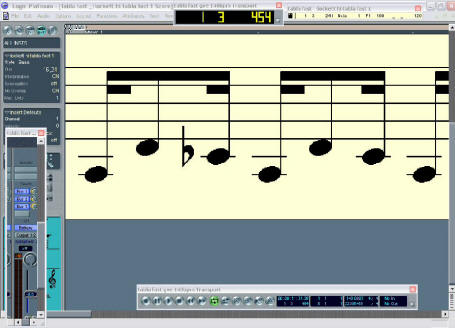
Screen shot 16;
Click to
enlarge
Here is the first bar of the bass part for this fast pattern. The bass
stays fairly on the beat and also fills any gaps in the treble part,
either with the bass tone or with the closed staccato bass tone.
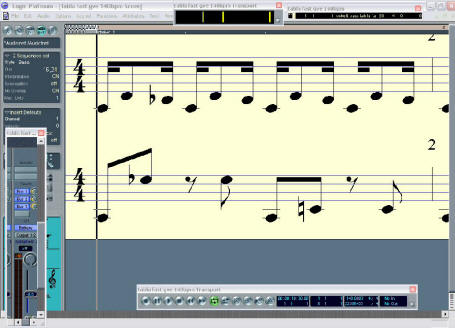
Screen shot 17;
Click to
enlarge
The whole bass part is actually four bars long. This is a characteristic
of Tabla where you can have one very short repetitive part on one hand
whilst the other hand defines the pattern over a longer period.
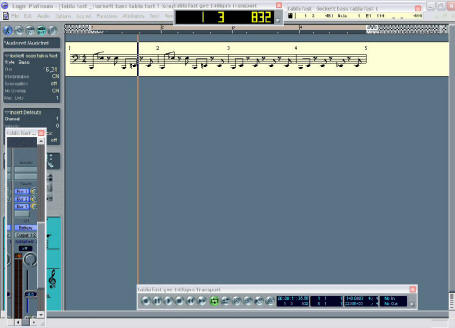
Screen shot 18;
Click to
enlarge
This pattern sounds much more complicated than it actually is. The bass
part repeats over two bars whilst the treble part is one bar long. The
treble part is based on the part of the previous example, just that
beats two and three of the bar turn the pattern around so it starts half
way through. (IE; if you were playing ABCD ABCD for the first two beats
of the bar, then for the third and fourth beats of the bar you would
play CDAB CDAB.)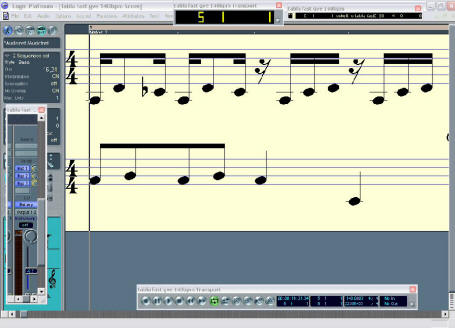
Screen shots
19-27 Fast rolls
Screen shot 19;
Click to
enlarge
The fast rolling often heard by Tabla players is probably the most
involved to conceptualize and program. The patterns are created by very
fast linear stroke combinations employing the staccato sounds on the
drums. For the purpose of actually playing this in on the midi keyboard
we needed to put a sample of the staccato closed bass tone in our hi
Tabla kit. We also left it panned in the centre so that when it was
employed with the staccato tones of the hi drum, it was not split off to
one side making the roll less effective. This is the one possible disadvantage of
recording Tablas in stereo.
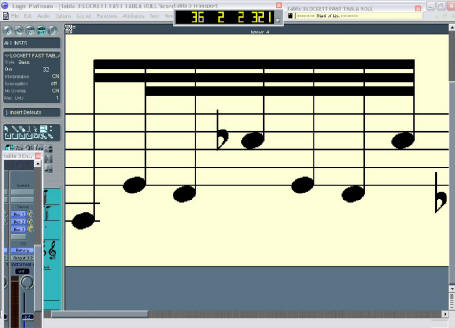
Screen shot 20;
Click to
enlarge
Notice how this roll is only using four strokes. Here we see is repeated
to fill one bar. Thinking of this in a division of quarter notes, this
would be divided 2+2+2+2 to make up the bar of 4 4
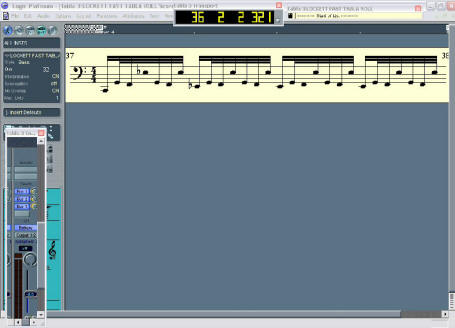
Screen shot 21;
Click to
enlarge
Now we are going to cut our part up into different length units to
create something slightly more interesting rhythmically. We changed the
snap to 8th's and cut some different length combinations.
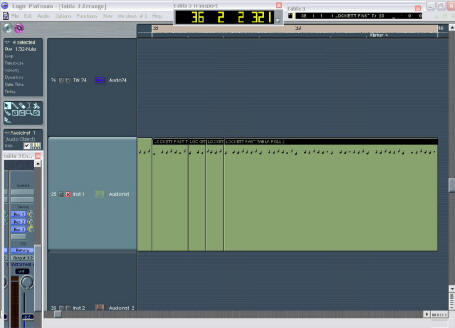
Screen shot 22;
Click to
enlarge
We got this pattern from joining a section two eighth notes long to a
section one eight note long. (It is 3 eighth notes long)
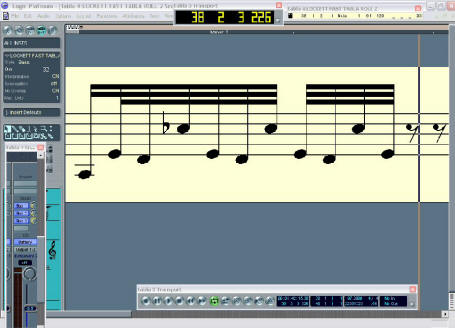
Screen shot 23;
Click to
enlarge
We repeated this in the arrange window three times to make a combination
of parts nine eighth notes long, divided 3+3+3.
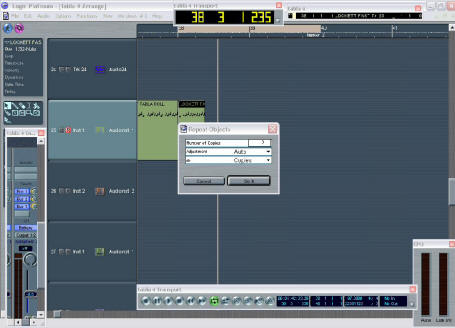
Screen shot 24;
Click to
enlarge
We then cut the ninth eight note from the end and deleted it, making our
combination of parts 3+3+2=8.
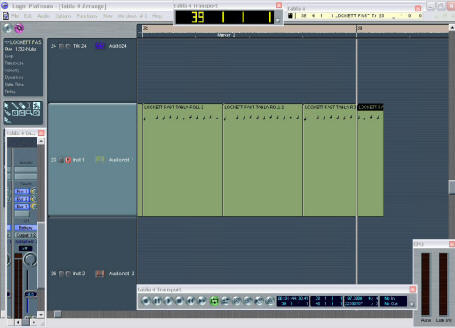
Screen shot 25;
Click to
enlarge
Then we merged objects from the functions menu, making one part of one
bar in length divided 3+3+2.
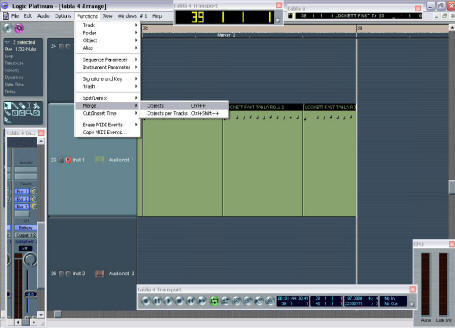
Screen shot 26;
Click to
enlarge
We then reinforced the accents on the resonant hi 'NA' tone from the hi
tabla with the bass tone of bass Tabla set.
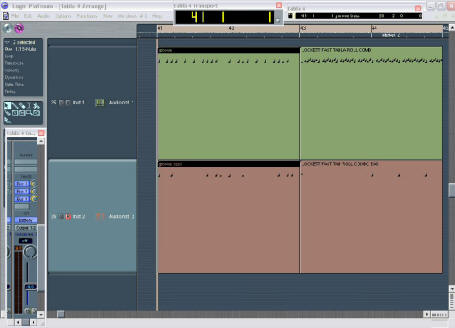
Screen shot 27;
Click to
enlarge
One funky groove later, we stuck elements of all this together and came
up with this.
